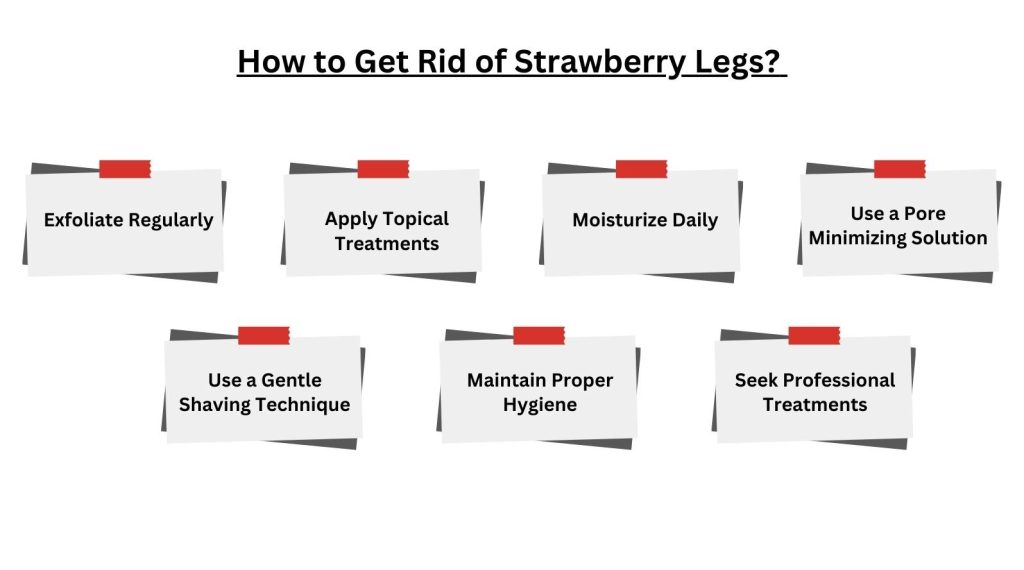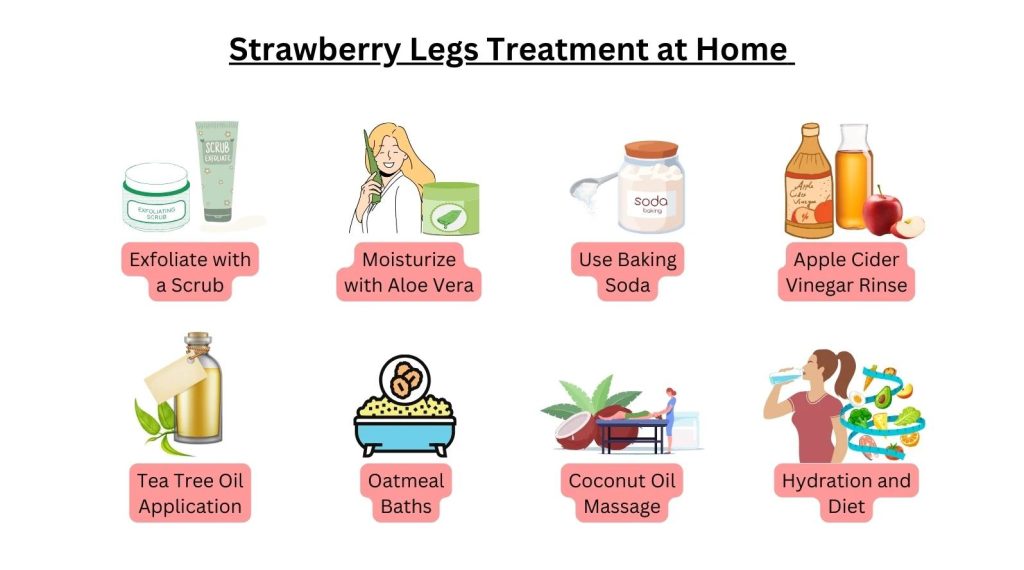Strawberry legs, characterized by the appearance of dark spots or dots resembling the seeds on a strawberry, are not a skin disease but rather a descriptive term for a common skin condition. This condition often occurs due to clogged pores, hair removal methods, or dry skin.
It is more likely to affect individuals with coarse or curly hair and those who shave frequently. People with larger pores or who have conditions such as keratosis pilaris may also be more susceptible.
While not harmful, strawberry legs can be a cosmetic concern for many, prompting the search for effective remedies.
What are Strawberry Legs?
Strawberry legs refer to the appearance of dark pores on the legs, giving the skin a speckled or dotted look similar to the seeds on a strawberry. This condition occurs when hair follicles or pores become clogged with dirt, oil, or dead skin cells, creating dark hair follicles that are more noticeable, especially after shaving.
While strawberry legs are not harmful, they can be a cosmetic concern for those seeking smooth, clear skin. Understanding the types and causes of strawberry legs is crucial for finding the most effective treatment and prevention methods.
Types of Strawberry Legs
Clogged Pores: This type occurs when pores on the legs become blocked with a combination of oil, bacteria, and dead skin cells. These clogged pores can appear as tiny dark spots, often exacerbated by shaving.
Folliculitis: Folliculitis is the inflammation of hair follicles, often caused by bacterial or fungal infections. This condition can lead to the appearance of dark hair follicles and red, irritated bumps, contributing to the look of strawberry legs.
Keratosis Pilaris: Also known as “chicken skin,” this condition involves the buildup of keratin, a protein that protects the skin. Keratosis pilaris can cause small, rough bumps on the skin, which may be mistaken for or contribute to the appearance of strawberry legs.
Dry Skin: Dry skin can accentuate the appearance of pores and hair follicles. When the skin lacks moisture, it can lead to flakiness and make dark pores on the legs more noticeable. Proper hydration and exfoliation are key to managing this type.
Is Strawberry Skin Genetic?
Strawberry skin is not directly classified as a genetic condition but can have genetic factors that contribute to its occurrence. Individuals with a family history of conditions like keratosis pilaris, which causes small, rough bumps on the skin, may be more prone to developing strawberry skin.
Additionally, genetic predispositions to dry skin, larger pores, or thicker body hair can increase the likelihood of experiencing dark pores on the legs. Although genetics can play a role, environmental factors and personal care habits also significantly influence the development and appearance of strawberry skin.
What Causes Strawberry Legs?
Strawberry legs are caused by a variety of factors that lead to the appearance of dark spots or pores on the skin. The condition typically arises from clogged pores, where oil, bacteria, and dead skin cells accumulate and create a darkened appearance.
Shaving can exacerbate this issue by irritating the skin and causing ingrown hairs, which also contribute to the dotted look. Other factors like dry skin, folliculitis, and keratosis pilaris can also play a role in developing strawberry legs.
Understanding these causes is essential for effectively addressing and preventing the condition.
How to Get Rid of Strawberry Legs?
Getting rid of strawberry legs involves a combination of proper skin care practices and targeted treatments to address the underlying causes. The goal is to unclog pores, reduce inflammation, and keep the skin hydrated and smooth. Implementing a consistent skincare routine that includes exfoliation, moisturizing, and appropriate hair removal techniques can significantly improve the appearance of strawberry legs.
Additionally, there are several home remedies and over-the-counter products specifically designed for strawberry legs treatment that can help achieve clearer, smoother skin.
 Exfoliate Regularly
Exfoliate Regularly
Regular exfoliation is crucial for getting rid of strawberry legs as it helps remove dead skin cells and prevent clogged pores. Using a gentle body scrub or a chemical exfoliant containing alpha hydroxy acids (AHAs) or beta hydroxy acids (BHAs) can effectively slough off dead skin, leaving the skin smoother and less prone to dark spots.
Moisturize Daily
Keeping the skin well-hydrated is essential in strawberry legs treatment. Using a moisturizer with ingredients like hyaluronic acid, glycerin, or ceramides can help maintain the skin’s moisture barrier and reduce the visibility of dark pores. Apply moisturizer daily after showering to lock in hydration.
Use a Gentle Shaving Technique
Shaving is a common cause of strawberry legs, so adopting a gentle shaving technique is important. Use a sharp, clean razor and shave in the direction of hair growth to minimize irritation and ingrown hairs. Applying a shaving gel or cream can also provide a smoother shave and protect the skin.
Try Hair Removal Alternatives
If shaving continues to cause issues, consider alternative hair removal methods such as waxing, sugaring, or laser hair removal. These methods can reduce the frequency of hair removal sessions and minimize the risk of developing dark pores and ingrown hairs.
Apply Topical Treatments
There are various topical treatments available for strawberry legs treatment. Products containing salicylic acid, glycolic acid, or retinoids can help exfoliate the skin, reduce inflammation, and prevent clogged pores. These treatments can be found in creams, lotions, or serums specifically designed for body use.
Use a Pore Minimizing Solution
Pore-minimizing products can help reduce the appearance of dark pores on legs. Look for products that contain ingredients like niacinamide or witch hazel, which can tighten pores and improve overall skin texture. Applying these solutions regularly can lead to noticeable improvements.
Maintain Proper Hygiene
Maintaining proper hygiene is vital for preventing strawberry legs. Ensure to clean the skin thoroughly, especially after activities that cause sweating. Using an antibacterial wash can help keep the pores clean and reduce the risk of folliculitis and other infections.
Seek Professional Treatments
For persistent cases of strawberry legs, seeking professional treatments may be beneficial. Dermatologists can offer advanced options such as chemical peels, microdermabrasion, or laser therapy. These treatments can provide deeper exfoliation and more effective results in reducing dark spots and improving skin texture.
Is Laser Therapy Good for Strawberry Legs?
Laser therapy is an effective option for treating strawberry legs, especially for those who struggle with persistent dark pores and ingrown hairs despite other treatments. This procedure works by targeting the hair follicles beneath the skin’s surface, reducing hair growth and minimizing the occurrence of clogged pores.
Laser therapy can significantly improve the skin’s appearance, making it smoother and less prone to developing dark spots. Additionally, it offers long-lasting results compared to traditional hair removal methods. Consulting with a dermatologist can help determine if laser therapy is the right choice for your specific condition and skin type.
Does Vitamin C Get Rid of Strawberry Legs?
Vitamin C is known for its numerous skin benefits, including its ability to brighten the complexion and reduce the appearance of dark spots. While it may not directly get rid of strawberry legs, incorporating Vitamin C into your skincare routine can help improve the overall appearance of your skin.
Vitamin C promotes collagen production, which can enhance skin texture and reduce the visibility of dark pores over time. Additionally, its antioxidant properties protect the skin from damage caused by free radicals and can aid in healing and preventing further irritation.
For best results, use a topical Vitamin C serum regularly and combine it with other treatments for a more comprehensive approach to treating strawberry legs.
Strawberry Legs Treatment at Home
Treating strawberry legs at home involves adopting a consistent skincare routine and using readily available remedies to reduce the appearance of dark pores. With regular care and the right techniques, it’s possible to achieve smoother, clearer skin without needing professional intervention.
Here are some effective home treatments for strawberry legs:
 Exfoliate with a Scrub: Use a gentle exfoliating scrub made from natural ingredients like sugar or coffee grounds to remove dead skin cells and unclog pores.
Exfoliate with a Scrub: Use a gentle exfoliating scrub made from natural ingredients like sugar or coffee grounds to remove dead skin cells and unclog pores.
Moisturize with Aloe Vera: Apply aloe vera gel to soothe the skin, reduce inflammation, and keep the skin hydrated.
Use Baking Soda: Create a paste with baking soda and water to gently exfoliate and cleanse the skin, helping to minimize dark spots.
Apple Cider Vinegar Rinse: Dilute apple cider vinegar with water and use it as a toner to balance the skin’s pH and reduce bacteria.
Tea Tree Oil Application: Apply diluted tea tree oil to target inflamed hair follicles and reduce the risk of folliculitis.
Oatmeal Baths: Soak in an oatmeal bath to calm irritated skin and provide gentle exfoliation.
Coconut Oil Massage: Massage coconut oil into the skin to moisturize deeply and reduce the appearance of dark pores.
Hydration and Diet: Drink plenty of water and maintain a balanced diet rich in vitamins and minerals to support overall skin health.
Closing Note
Getting rid of strawberry legs involves a combination of proper skin care, effective hair removal techniques, and consistent hydration. By incorporating regular exfoliation, moisturizing, and gentle shaving practices into your routine, you can significantly reduce the appearance of dark pores and achieve smoother skin.
Exploring home remedies and professional treatments like laser therapy can further enhance your results. With the right approach and persistence, strawberry legs can be effectively managed, leaving you with clear and healthy-looking skin.

